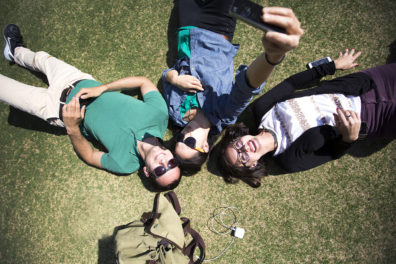
Parts of the Los Angeles community: LACMA, The Broad, and The Getty. Photos from left: Flickr users Susan Broman, Melissa Delzio, and Photos by Clark, CC BY-NC 2.0
Why have New York, Chicago, and Los Angeles remained such vital centers of trade and finance over the years, constantly reinventing themselves to meet the ever-changing needs of the world’s economy? In great part because they have always welcomed immigrants hungry for work and cultural freedom and, in the process, not always easily but ultimately successfully, have built a dynamic, multilingual, and cosmopolitan community open to all that the world has to offer.
My wife and I lived in Chicago for seven years, from 2004 to 2011. We came to know it well and to feel a part of it quickly, easily. In its first century, it was one of the fastest-growing cities in the world, doubling every decade through most of the 19th century. By 1890, the city that had had only 30,000 residents at mid-century was the fifth largest city in the world, with large numbers of immigrants from Ireland, Italy, Germany, Poland, Sweden, and Mexico. Today its population is almost three million, with large numbers of immigrants from Bosnia, India, Nigeria, and Southeast Asia. Almost 30 percent of its population speaks a language other than English at home. For the six-county area that comprises Greater Chicago, the five most common languages after English are Spanish, Polish, Arabic, Chinese, and Tagalog.
What helps Chicago attract and integrate its ever more diverse population? Among other things, I would argue its cultural institutions.
I had the great honor to have directed the Art Institute of Chicago for seven years. I came to understand it as a place where the city’s many and diverse residents meet to explore their differences and similarities and find common ground. I remember experiencing this profoundly one day.
It was 4:30 on a Thursday afternoon. From my office I could see dozens of people standing in line waiting to enter the museum. We were open and had been open for six hours already by then. The people waiting in line could have entered then; others did. But every Thursday at five o’clock we suspended our admission price and allowed people into the museum for free. And so often they waited, crowds of them, like those in line visible from my window. In thirty minutes and over the course of the next three hours, they were joined by thousands of others, people of all ages and interests, from a broad range of ethnic, religious, social, and economic backgrounds, some experienced in museum-going, others with little or no preparation, all of them coming to look at works of art.
I found this moving, even inspiring. Life is hard and the people outside my window were busy. Likely they had worked all day, fed their families, and traveled downtown by train. Likely too they were tired and had come to the museum when there were many other, equally free cultural activities nearby. Why did they make such an effort to come to the museum?
Out of curiosity, for education, inspiration, entertainment, distraction, comfort, safety, a sense of community; to see beautiful things, new and different things; to have their view of the world enlarged, feel a part of something important—the long and richly textured history of human existence.
And what did we offer them in return? Our collections, often displayed with helpful and informative labels and accompanied by audio guides or gallery docents who tell them something about the artists who made the works on view, the era in which they were made, their subjects, their place in the history of art, and, not to be overlooked, their authenticity; special exhibitions that focus on the work of a particular artist, artistic period, subject matter, or regional culture; exhibitions that bring together works from of art from disparate collections that couldn’t otherwise be seen in just this way; sometimes lectures, concerts, films, literary events, or educational workshops designed to enrich the experience of our collections; but always, always, works of art in all of their stubborn reality properly cared for and presented so as to provoke investigation and inquiry into the realities of the past as an antidote to a wistful or determined nostalgia for a past that never existed precisely as it is said to have done.
People were coming to the museum because they hungered to have their world enlarged, their life enriched by the experience of new and strange, wonderful things, and sense made of the differences they confront in the polyglot, multiethnic world in which they live, not just as a condition of life lived throughout history, since people first traveled beyond their villages and came into contact and forged relations with people and cultures unfamiliar to them, but still today, as people move about the world in pursuit of new experiences and better futures.
Museums in New York, Chicago, Los Angeles, and other global cities are public places where different peoples gather to confront the world’s many cultures. And in this way, they promote cultural understanding and tolerance of difference in others.
As we watch political rhetoric this presidential electoral season resort to the most violent of metaphors to describe the differences between cultures, we should promote the promise of our museums as places of community and understanding of our undeniably intertwined similarities.
_______
This post originally appeared on Global Insight, the blog of the Chicago Council on Global Affairs. Jim Cuno speaks at the 2016 Chicago Forum on Global Cities, held June 1–3, 2016.




Comments on this post are now closed.